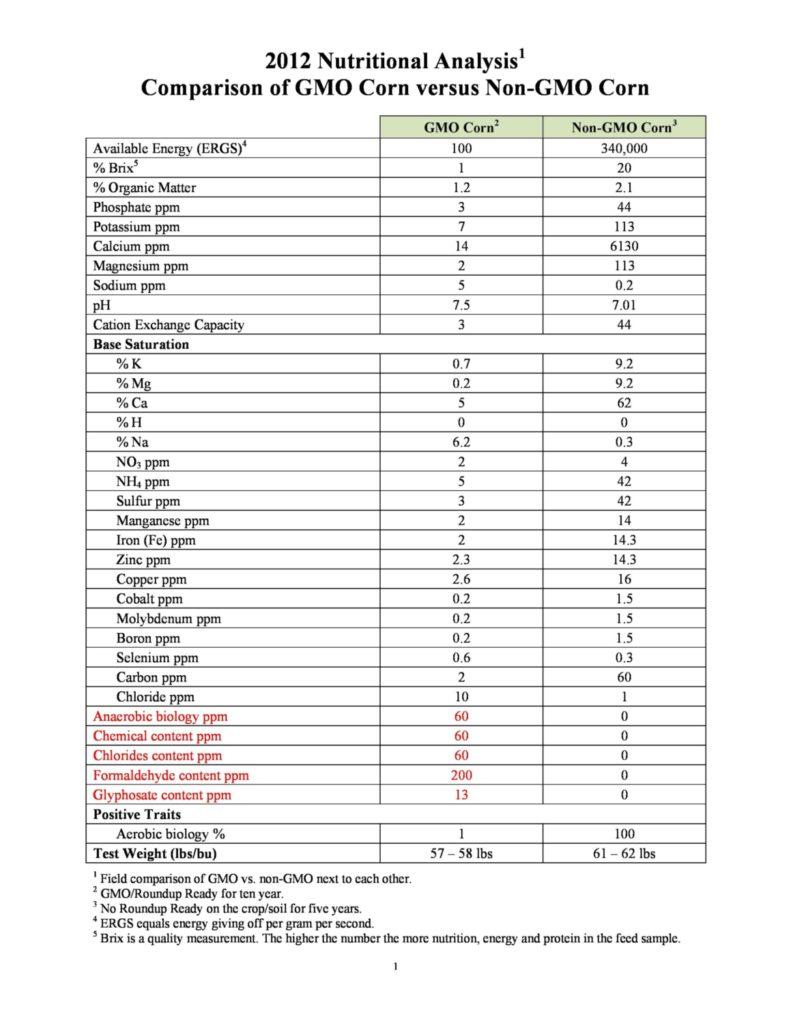We love to measure things. We hope by counting Nutrition Facts we can know how GOOD a food is for us. But how effective is it? What about the vast nutritional gap between the three realms of food: Organic vs. “Conventional” vs. GMO? What’s the effect of chemicals on complete nutrition? Obviously, this will vary depending on the type of seed, minerals and microbes in the soil, growing conditions, and freshness of the food. Ha Ha! Did you know that calorie and carb counts are based on average measures taken many years ago, long before modern industrial toxins appeared?
And BTW how well do you chew your food? Even if we could somehow magically estimate the nutritional value of food you put INTO your mouth, how much of that nourishment is actually absorbed? We’ll never know! Ha Ha! Then consider the facts that your body is constantly swapping molecular nutrients, and that your friendly intestinal microbiome is a veritable nutrient factory. So, what you put IN will never equal what you receive. Yep. Calories and nutrition labels are gross estimates at best. And vitamins are another open question. Ha Ha! Maybe we should just think about eating COMPLETE FOODS. What a concept!
What if we just put aside our calculators and eat complete, unprocessed foods without trying to fractionate every single nutrient? Counting nutrients in food has almost nothing to do with optimizing health. Just think of how much time we’ll save! If our goal is HEALTH, perhaps more relevant questions are: Is there any life force in the food? Is it grown in healthy soil? Is it free of toxins? So, I’m wondering – why spend my valuable time counting what’s going INTO my body, if it’s only a small fraction of the whole picture? Perhaps counting can be a useful guide occasionally. But not today! Sorry for the tirade! Ha Ha! Personally, I don’t have time to count incomplete estimates. Anyway, it’s YOUR choice. Best wishes for your complete health!
Executive summary:
1. We’re all Mineral Deficient from Modern Soil with Farming Chemicals. It’s a world-wide mineral deficiency due to chemicals in industrial food and soil. Years ago, our soil was rich in nutrients and beneficial microbes. Modern genetically modified seeds and chemical farming kill soil microbes and deplete minerals. So, we are all nutrient deficient and disease-prone, suffering the resulting chronic diseases such as Hypertension, Diabetes, Heart disease, and Cancer.
2. Scientific research tells us that the nutrients we actually absorb are only 10% to 80% of what we consume. Your personal absorption rate depends on countless factors such as how well you chew your food, your diet, age, metabolism, intestinal flora, mental state, and more. If you’re emotionally agitated or upset, you won’t absorb very much.
3. Calorie counts are unreliable. According to the FDA, over 10% of nutrition labels contain errors. Calories were invented 200 years ago to measure heat in a steam engine, which cannot accurately describe the complexities of human metabolism. Nutrition tables for common foods are based on decades-old studies and gross estimates that cannot take all variables into account. These inaccuracies make nutrition labels and calories highly questionable.
4. Are Nutritional Labels Reliable? The FDA does not verify nutrition labels, and there are countless errors.
The FDA itself estimates that roughly 10% of food labels contain inaccuracies.
5. How much life force is in our food today? Freshly picked local vegetables, fruits, meats, seeds, and nuts are rich with life force. Processed foods such as chips, crackers, energy bars, and bread are generally low in life force. Although it’s hard to count, it would be far more relevant to measure the life force, or Qi in your food. In general, original living foods have life force. Processed and stored foods do not.
6. Your body is a biochemical factory, constantly swapping molecules to create nutrients you need. We can count the nutrients going IN. But this will not tell us what nutrients are being transformed, stored, or synthesized by the body. Therefore, counting nutrients you consume is going to be inaccurate.
7. Forget counting and boost nutrient absorption. Rather than measuring only what goes IN, it is far more beneficial to focus on improving nutrient assimilation. How do we do that? The best ways to maximize nutrient absorption are: Chew your food really well. Eat quality food produced and prepared with love. Eat small to moderate quantities. For highest bio-availability, eat mostly lightly cooked warm food, and some raw young plants, all unprocessed. Eat a balanced diet. Exercise, and follow a healthy lifestyle appropriate for your body. Avoid toxins and emotional stress. It’s better to spend more money on quality food and eat less, than to eat larger quantities of poor quality food. Just imagine all the money, time, and energy we can save! For more details, read on.
1. We’re all Mineral Deficient from Modern Soil with Farming Chemicals
People with diabetes often have a deficiency of chromium and zinc. Low magnesium has been linked to Heart myocardial ischemia and cancer. Microbiome imbalance is everywhere inside us and around us. It’s a world-wide mineral deficiency due to chemicals in industrial food and soil. Minerals are often a forgotten element, yet they are fundamental requirements for life. Years ago, our soil was rich in nutrients and beneficial microbes. Modern chemical farming kills soil microbes and depletes minerals in plants.
To make matters worse, every step of processing reduces nutritional value in our food even more. Minerals are necessary for strong bones, teeth, blood vessels, muscles, and brain function. So, we are all nutrient deficient and disease-prone, suffering chronic diseases such as Hypertension, Diabetes, Heart disease, and Cancer.
Have you ever seen a comparison in nutritional values between organic vs. food raised with industrial chemicals? No? Well, that’s because this info is mostly hidden. You can’t find it. I did manage to find a comparison of GMO to NON-GMO, corn, which unfortunately doesn’t even address the organic issue.
Take a look at this corn comparison. The important thing to note is that these are exactly the deficiencies in a human being that lead to susceptibility to sickness, disorders, and cancer. People who have osteoporosis are low in calcium and magnesium, people who have cancer are low in manganese. The list goes on and on.
- GMO Corn has 14 ppm of Calcium and NON-GMO corn has 6130 ppm. 437 X more.
- GMO corn has 2 ppm of Magnesium and NON-GMO corn has 113ppm. 56 X more.
- GMO corn has 2 ppm of Manganese and NON-GMO corn has 14ppm. 7X more.
- Look at the levels of Formaldehyde and Glyphosate IN the corn!
- The EPA standard for Glyphosate in water in America is .7ppm. European Tests showed organ damage to animals at .1ppb (.0001ppm) of Glyphosate in water. Our water levels allow glyphosate 7,000X higher than what has been shown to be toxic in animals. This corn has 13 ppm! 130,000 times higher than what is toxic in the water!
Another recent study showed that on average organic produce had 27% more vitamin C, 21% more iron, 27% more magnesium and more than 13% more phosphorous than conventional produce. These facts can be referenced in Dr. John La Puma’s book “Chef MD’s Big Book of Culinary Medicine“.
We can heal our mineral deficiency. First, we need to buy from local farmers, balance farming to remove toxic chemicals, build the body microbiome, and take mineral supplements to optimize health. Here are two of my favorite supplements. Check out Ion Gut Health by Zach Bush MD, and ICMD Mineral Drops.
2. How Much of Your Food is Really Absorbed?
Research says your body actually assimilates between 10% and 80% of the food you eat, the average somewhere in between. The rest is excreted, recycled back into the Earth. How much you assimilate depends on many factors, which fluctuate constantly and are not easy to measure. The primary factors are: how well you chew your food, the nutrient-density of the food, the type of food (i.e. meats, vegetables, seeds), whether it is raw or cooked, the level of life force in the food, enzymes present, your intestinal flora, your emotional health, stress level, and any toxins or useless material that must be eliminated. Other important factors are your metabolism, exercise and activity level, the quantity of food consumed, your age, the time of day, your internal body temperature, and the temperature of the food consumed.
Animal Studies of Food Absorption
Scientific studies in animals show that grazers assimilate 20-40% of the energy from grass, and the rest is excreted. (Have you seen a cow pie recently? It’s full of undigested grass.) Animals who live on a diet of young leaves and plants absorb more – 60 to 70% of the energy taken in. Seed-eaters absorb up to 80% of their food. Carnivores assimilate the highest percentage – 80 to 90% of their food eaten. What about humans? Humans eat plants, and some eat meat. Energy assimilation of meats is generally higher than that of plants. Studies show that light cooking of plants increases its bio-availability, so that more of the nutrients can be absorbed. Your personal absorption rate depends on what you eat and the factors above.
Your digestion is an amazing sorting mechanism.
With intelligence and precision your body knows what to absorb, what to block, and what to throw away. For example, processed food contains a high percentage of useless material. Your body is so smart that if toxins or garbage enter the digestion, it builds a natural barrier in the intestinal lining called mucoid plaque. This serves as a filter to keep them from entering the bloodstream. Unfortunately, it also blocks your ability to absorb real nutrients. This is one reason some people are able to reach middle age eating a diet of junk food – their digestive system blocks and excretes the garbage. The body is highly efficient, so that when food is scarce, it works to absorb more of it. Likewise when food is abundant, it eliminates a higher percentage of it. Therefore, measuring food INTAKE doesn’t tell you much about what’s getting assimilated. This is definitely food for thought…
3. What’s a Calorie Anyway?
The concept of a calorie was introduced in 1819 by French chemist Nicholas Clément, who analyzed the energy input and output of steam engines. He coined the French word “calorie” (from Latin “calor”, meaning “heat”) as “the amount of energy required to heat 1 kilogram of water by 1 degree Kelvin.” A half century later in 1887, American Wilbur O. Atwater first applied the term calorie to food. Surprisingly, the primary motivation in their calorie calculation was to determine the cheapest way to perform heavy work, using manual human labor or steam engines!
Your Body is Not a Steam Engine
Your body is a dynamic, intelligent, adaptive, living organism. It can’t be measured like a steam engine. Your body is wise. It can “gear up” and “gear down” its metabolism, or energy consumption depending on myriad factors such as stress, hormones, metabolic demands, and perceived food availability. Digestion is a complex process with countless moving parts, including the trillions of helpful intestinal bacteria that “digest” the food for you. How efficiently you assimilate food can affect the energy you receive from it by a huge amount. Energy consumption also varies by time of day, with higher burning in the morning. Metabolism speed varies widely from person to person. The energy consumed walking up a flight of stairs may be quite different for a trained athlete, a child, and an older person. This makes me wonder: Are calories an effective measure of body energy? Can a steam engine’s heat input and output be applied to human metabolism with any accuracy at all?

Nutrition labels are confusing and stressful for many people.
4. Are Nutritional Labels Reliable?
The FDA does not verify nutrition labels, and there are countless errors.
The FDA itself estimates that roughly 10% of food labels contain inaccuracies. If an error is suspected, a label must be off by 20% before risking a penalty. Standard boiler-plate tables for foods are often used to calculate nutrition facts, and this invites further error. That’s because other hard-to-measure factors have a significant effect on the nutritional content of a given food, such as how it is grown, the quality of the soil, its water content, ripeness when harvested, how long ago it was harvested, the particular species, how it is prepared, and how much it is heated. All these factors make the labels estimates at best.
Forget the Nutrition Labels?
My personal approach is to buy nutrient dense, original, unprocessed foods, and relax, knowing that my calorie and nutrient needs are covered. For the few packaged foods that I buy, I speed-read the ingredient list for red flags such as GMO’s, sugars, and toxins. It’s fast. To learn how, see my article 3 Easy Steps to Speed-Read Nutrition Labels. I don’t look at calories or nutrition facts. I don’t waste my energy worrying about label inaccuracies. Everyone knows there’s more real nutrition, enjoyment, life force, and flavor, in original unprocessed foods.
5. How Much Life Force is in Our Food Today?
Although it’s more difficult to count, it would be far more relevant to measure the life force, or Qi in your food. Is your food energetically alive, or is it empty? Light cooking does not destroy the energy in foods; in most cases it makes food more bio-available. How can you recognize life force? In general, original living foods have life force. Processed and stored foods do not. That means fresh vegetables, fruits, meats, seeds, and nuts are rich with life force. Processed foods that do not go bad such as chips, crackers, energy bars, and bread are generally low in life force. When we eat processed foods, the body is full and feels temporarily satiated, however they do not offer benefit, and are excreted. Digesting food requires enormous energy. Eating empty food requires the body to sort through unwanted garbage, and this depletes our digestive strength.
6. Your Body is a Nutrition Factory!
Your body swaps nutrients to create new ones! The transformation of nutrient materials within your gut defies measurement. Metabolism is a continual process of chemical exchange within living cells. Some nutrients are consumed, while other nutrients can be synthesized by the microbiome and body cells. We know the cell’s metabolic machinery can transform some nutrients into other forms by rearranging their atomic components and chemical bonding. A familiar example occurs after you eat an excessive amount of carbohydrate in the form of sugars – your body cells can transform these sugars into fat. Likewise, excess proteins are also converted into fat. In another example, the body usually builds cells with amino acids, the building blocks of protein. However, it can also swap molecules to convert those amino acids to glucose and then burn the glucose for energy.
Your intestines are a biochemical melting pot of nutrients. For example, your intestinal bacteria synthesize Vitamin K, Vitamin B12, and fatty acids, which give you energy and build strong cell walls. Vitamin D is synthesized by the skin cells using sunlight. Many amino acids can be manufactured by the body (alanine, arginine, asparagine, aspartic acid, l-cysteine, glutamic acid, glutamine, glycine, histidine, ornithine, proline, selenocysteine, serine, taurine, and tyrosine). These are just a few examples of the transformation and creation of nutrients going on in your body.
We can count the nutrients going IN. But this will not tell us what nutrients are being swapped, changed, and synthesized inside the body.
7. Forget Counting. Instead Boost Assimilation.
Instead of counting calories and carbs, it is more important to boost assimilation and build strong metabolism by eating more of the right kinds of nutrient-dense foods and exercising intelligently. The quality of your food REALLY matters. So, when you eat good food, your total body health improves all by itself.
Best ways to maximize your nutrient absorption:
- Chew your food very well. This is #1. Studies show that life expectancy and digestive health are directly linked to how many times you chew your food! Food must be reduced to a single molecule to be absorbed. Chewing it well mixes your food with digestive enzymes and vastly improves assimilation.
- Eat quality food, produced and prepared with love, in small to moderate quantities.
- Eat mostly lightly cooked warm food, and some raw food from young plants.
- Eat a balanced diet.
- Exercise, move a lot, and live a healthy lifestyle for your body.
- Avoid toxins and emotional stress.
- It’s better to spend more money on quality food and eat less, rather than eating larger quantities of poor quality food.
Still want to count calories and carbs? Here’s how.
When I stopped eating sugars, my weight issues disappeared. Then I discovered that freshly picked, organic foods are significantly higher in vitamins, minerals and nutrients than stored foods and foods raised with chemicals. I learned the nutritional numbers are gross estimates, and they vary widely with different plant varieties, soils, growing conditions, and harvesting time. Later I discovered that the alkalinity of our food, our water quality, and sleep level are the three primary determining factors in our health. Then I found out most people absorb only 45 – 55% of the food we eat, depending on how we chew, the health of our gut bacteria, and our emotional state. Wow!
So, you can understand why I don’t count nutritional value. However, I do understand that approximate nutritional numbers may be useful in some cases. You can compute them yourself at this website – just cut and paste the ingredient quantities: https://www.verywell.com/recipe-nutrition-analyzer-4129594
“A FOOL eats perfect food, and transforms it into crap.
A WISE PERSON eats what is offered, and then transforms it into harmony and wisdom.”
– Rudi
Resources:
- Do We Absorb All the Calories in Our food?
- What is Digestion?
- Social Adaptation to Food Stress: A Prehistoric Southwestern Example, by Paul E. Minnis
- Enzyme Nutrition by Edward Powell
- Where Nutrition Labels Lie
- Proposed Changes to the Nutrition Facts Label
- Nutrition Facts are Inaccurate
- Nutrition Data Gone Wild
- Food Energy and Calories
- Online Textbook of Bacteriology
- Advanced Human Nutrition, By Denis M Medeiros
- Intestinal Failure: Diagnosis, Management and Transplantation, edited by Alan N. Langnas
- Gut Flora – Intestinal Flora
- Gastro-Intestinal Tract – Intestinal Fatty Acid Metabolism
- How Chewing Your Food Properly Can Extend Your Life & Prevent Disease
- https://simplysplendidfood.com/category/organic-food/
- https://pubmed.ncbi.nlm.nih.gov/20359265/
- https://www.momsacrossamerica.com/stunning_corn_comparison
- https://the100yearlifestyle.com/stunning-gmo-corn-comparison/







No Replies to "Still Counting Calories & Carbs?"